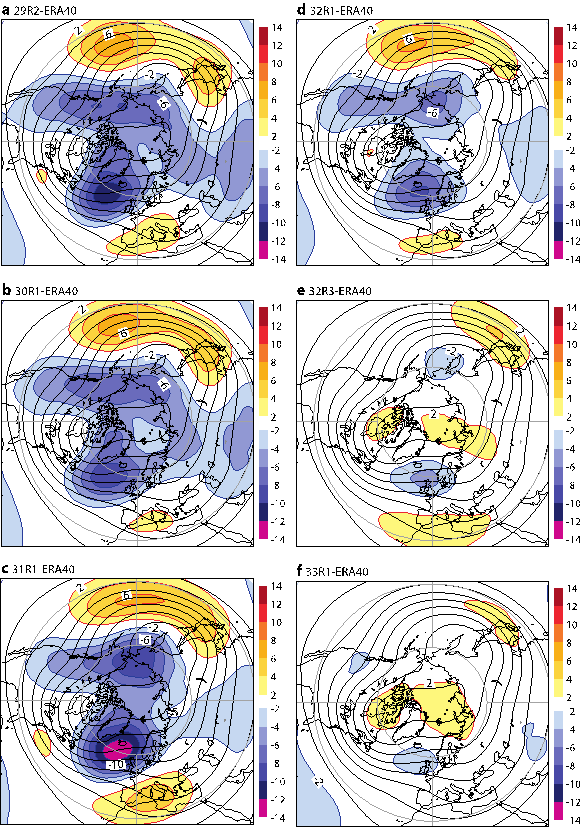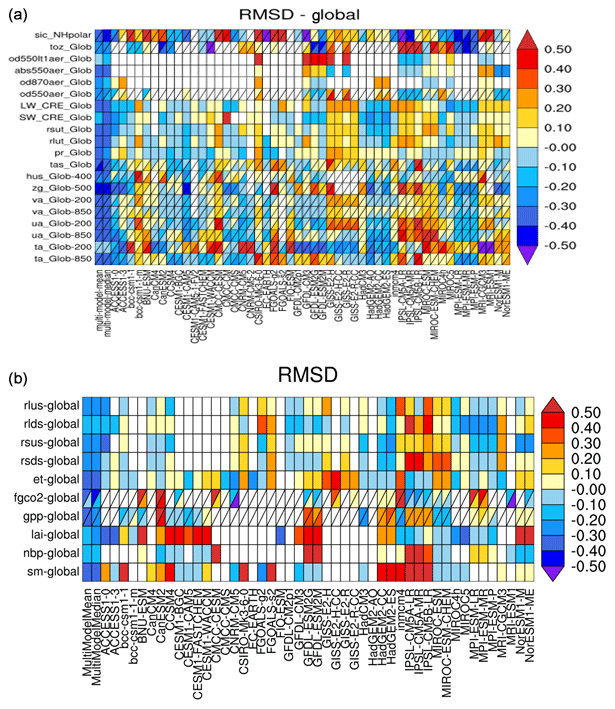S1: Diagnosis and Metrics in Climate Models
Principal investigators: Prof. Hans Burchard (Leibniz Institute for Baltic Sea Research Warnemünde), Prof. Veronika Eyring (MARUM/University of Bremen), Prof. Thomas Jung (Alfred Wegener Institute for Polar and Marine Research/MARUM/University of Bremen), Prof. Nedjeljka Žagar (Universität Hamburg)
Objectives
In a continuation and extension of the S1 subproject from the first phase of the CRC, S1 will assess the impact of model developments – proposed by the other project areas – on the quality of two climate models developed and used by the German scientific community, namely ICONa/ICON-o and OpenIFS/FESOM2. Major parts of the work will be organized around performing numerical simulations with new parameterizations, and development and application of new metrics, diagnostics and tools for model evaluation in terms of model biases and response to forcing.
Numerical simulations will be performed for a hierarchy of model setups, ranging from simplified channel models to realistic global coupled high-resolution simulations following CMIP6 protocols. These simulations will provide the basis for further model evaluation. Scalable open source tools for processing and evaluation of this data will be further developed and shared with the community. We will continue using diagnostics developed in the first phase, and implementing additional diagnostics already published in the literature. Moreover, we will develop new diagnostics that will help us to evaluate models in the context of their energetic consistency.
The new diagnostics will extend the validation of the scale-dependent spatial variability performed by the MODES software to the temporal domain. The extension will include a novel method that quantifies the effects of model biases on the simulated spatio-temporal variability. Remote effects of model biases – here called bias teleconnections – will be initially investigated in a GCM of intermediate complexity, then applied to ICON-a/ICON-o and OpenIFS/FESOM2 including new parameterizations.
Numerical mixing and dissipation are potential sources of large errors in ocean components of climate models. New numerical schemes developed in the CRC to tackle these shortcomings need to be properly evaluated. Therefore, methods to quantify numerical errors in water mass transformations will be further developed in M5 during the first two years and implemented and evaluated in FESOM2 during the last two years of the second phase of S1.
Results of ICON-a/ICON-o and OpenIFS/FESOM2 model simulations will be put into a broader climate modelling context (with emphasis on CMIP6 simulations). The Earth System Model Evaluation Tool (ESMValTool), a community diagnostic and performance metrics tool for routine evaluation of climate models, will be enhanced with the offline diagnostics developed within this project. By making additional use of a wide range of diagnostics already included in the new ESMValTool version 2.0 (v2.0), the impact of model developments will be thoroughly evaluated, also in the context of CMIP6 models.
Phase 1

The hypothesis underlying the proposed Collaborative Research Centre is that a more consistent representation of parameterised processes and numerical formulations will result in better climate models. To test this hypothesis, therefore, it is critical to thoroughly evaluate the influence of enhanced model formulations, developed in the other project areas, on the realism of climate models. Here, we will focus on two next-generation climate models developed and used by the German climate research community, namely ICON-a/ICON-o and ECHAM6/FESOM.
Efforts towards developing a new generation of energetically consistent models require the availability of tools that can help to identify short-comings and quantify progress (e.g. Figure 1). Therefore, we will develop and apply new diagnostics and metrics that help us to understand the pathways of energy transport and energy conversion, analyse the energetic consistency of existing models and formulate measures taken up by the other subprojects to advance the energetic consistency and quality of parameterisations of climate models. Furthermore, we will develop effective metrics and diagnostics that can be used to quantify the realism of models and unravel the origin of model error. Metrics describing systematic model error in atmosphere, ocean and sea ice using some of the most advanced observational data sets for reference, will be elaborated. Furthermore, dedicated metrics will be developed that capture important weather and climate phenomena resulting from instabilities such as extratropical storms, Euro-Atlantic blocking, or monsoon dynamics. Finally, we will construct metrics able to analyse consistently a large class of extremes occurring across a wide range of spatial and temporal scales.
An important aspect will be the practical implementation of new tools that can be used for model evaluation. We will build on the newly developed Earth System Model Validation Tool (ESMValTool)—a community diagnostic and performance metrics tool for routine evaluation of climate models. By doing so, we can also benefit from other community efforts in developing evaluation tools. Moreover, we can add our new metrics and diagnostics to ESMValTool thereby increasing the applicability and international visibility—and hence the impact—of the research coming out of this subproject.

To aid effective evaluation of the model development activities, coming out of the other research areas, and to guide further efforts, we will design protocols for numerical experimentation, including common model setups, together with the PIs from subproject S2. These protocols will allow direct comparability between different modelling experiments, ensure availability of model output needed to compute all relevant metrics and diagnostics and provide a framework to evaluate model changes in the context of CMIP6-type experiments with ICON-a/ICON-o and ECHAM6/FESOM.
The results will be made available through a web-based tool—the Diagnostics and Metrics Explorer—for effective analysis. We will take advantage of direct collaboration with ongoing Horizon2020 projects (CRESCENDO and PRIMAVERA) dealing with evaluation of Earth System Models in the context of CMIP6.
Discover
FESOM model
One of the two ocean models used in the TRR181 project is FESOM (Finite-Element/volumE Sea ice-Ocean Model), which is part of the AWI-CM climate model of the Alfred Wegener Institute, Helmholtz Centre for Polar and Marine Research (AWI).
FESOM is the only ocean model participating in CMIP6, that is formulated on an unstructured mesh. This allows scientists to flexibly increase horizontal resolution of the model in more energetically active areas of the ocean like the Gulf stream or Agulhas current. The resulting model resolves important details of ocean circulation, but is still computationally efficient.
FESOM ocean currents in Indian and Pacific oceans (100m)
Reports
The Earth’s energy budget and other funny aspects of the thermodynamics of the climate system
State-of-the-art climate models still struggle to reproduce a reasonably energetically consistent system, even though outstanding improvements have been achieved in the recent past.
The idea of this subproject is assessing the impact of introducing new numerical schemes and physical parametrizations developed in the TRR181 for the energy closure of state-of-the-art climate models. We provide diagnostic tools that allow for evaluation and intercomparison of climate models, starting from their outputted datasets.
It might sound trivial, expecting that the climate system, if in steady state, is also in thermodynamic equilibrium. This is at least what our studies of classical thermodynamics suggest. The problem is that the system constantly exchanges energy with its exterior, i.e. the outer space, and within its interior. In steady state conditions, the net exchange of energy with the exterior has to be null. In other words, the climate system is in thermodynamic equilibrium, once we averaged out the modulation of the solar energy input to an appropriately long timescale and all the energy exchanges occurring in its interior, shaping the solar “reflection” and the thermal energy output. This is a clear example of what is called a “non-equilibrium dissipative steady state thermodynamical system”.
State-of-the-art climate models still struggle to reproduce a reasonably energetically consistent system, even though outstanding improvements have been achieved in the recent past. This points to the very basic reasons for climate modeling, on one hand reflecting the lack of understanding of some processes involving energy exchanges and the limits of the discretization/truncation of the real world in finite dimension models, on the other hand preventing us from correctly evaluating the impact of the various forcings for reconstructed and projected climate change.
As TRR181, we are participating to the community effort called “ESMValTool”, whose aim is providing a set of standardized diagnostics for the evaluation of state-of-the-art and forthcoming multi-model ensembles. In our diagnostics, we try to address specifically the Earth’s energy budget and its atmospheric and oceanic components, and the atmospheric energy exchanges, including the Lorenz Energy Cycle, which describes the energy exchanges in the extratropical synoptic eddies. We also provide an estimate of the atmospheric material entropy production, i.e. the entropy production through irreversible processes, and the water mass budget, which is known to be one of the main sources of uncertainty for the modeled energy budget.
The diagnostic tool is currently being ported from version 1 to version 2 of ESMValTool, and will be hopefully soon publicly released. A report for the ESMValTool version 2 is being written, with contributions by all groups in the community, and another paper, focused on potential applications of the tool in various fields of climate science, will be submitted.
Metrics and Diagnostics for model improvements
The proper protocol and experiment setup for numerical experiments is crucial.
I am Nikolay Koldunov, Post Doc at MARUM and Alfred Wegener Institute. Since October I begin to work at Research Project S1: Diagnosis and Metrics in Climate Models. The main aim of the project is to integrate and synthesize work done in other parts of the TRR181. In particular we will provide metrics and diagnostics to help access the impact of model improvements suggested by TRR181 on quality of the climate models. One of the main challenges is to create model diagnostics that would not only quantify improvements, but also allow to clearly identify the cause of changes in model behavior. In this respect the proper protocol and experiment setup for numerical experiments is crucial and its development will be important part of my work. The resulting diagnostics will become available for the wider research community through the ESMValTool, that is going to be one of the main instruments of model analysis for the CMIP6 project.
Publications
Chang, Y., Li, X., Wang, Y.P., Klingbeil, K., Li, W., Zhang, F. & Burchard, H. (2024). Salinity mixing in a tidal multi-branched estuary with huge and variable runoff. Journal of Hydrology 634, 1-16, doi: https://doi.org/10.1016/j.jhydrol.2024.131094.
Wang, Q., [...], Koldunov, N., [...], Scholz, P. et al (2024). Impact of increased resolution on Arctic Ocean simulations in Ocean Model Intercomparison Project phase 2 (OMIP-2). Geosci. Model Dev. 17, 347–379, doi: https://doi.org/10.5194/gmd-17-347-2024.
Li, X., [...], Danilov, S., Koldunov, N., [...] & Jung, T. (2024). Eddy activity in the Arctic Ocean projected to surge in a warming world. Nat. Clim. Chang., doi: https://doi.org/10.1038/s41558-023-01908-w.
Koldunov, N. & Jung, T. (2024). Local climate services for all, courtesy of large language models. Commun. Earth Environ. 5(13), doi: https://doi.org/10.1038/s43247-023-01199-1.
Henell, E., Burchard, H., Gräwe, U. & Klingbeil, K. (2023). Spatial composition of the diahaline overturning circulation in a fjord-type, non-tidal estuarine system. J. Geophys. Res. - Oceans 128, e2023JC019862, doi: https://doi.org/10.1029/2023JC019862.
Zhao, Y.-B., Žagar, N., Lunkeit, F. & Blender, R. (2023). Atmospheric bias teleconnections in boreal winter associated with systematic sea surface temperature errors in the tropical Indian Ocean. Weather Clim. Dynam. 4(4), 833–852, doi: https://doi.org/10.5194/wcd-4-833-2023.
Reinert, M., Lorenz, M., Klingbeil, K., Büchmann, B., & Burchard, H. (2023). High-Resolution Simulations of the Plume Dynamics in an Idealized 79°N Glacier Cavity Using Adaptive Vertical Coordinates. J. Adv. Model Earth Sy. 15(10), e2023MS003721, doi: https://doi.org/10.1029/2023MS003721.
Shi, J., Stepanek, C., Sein, D., Streffing, J., & Lohmann, G. (2023). East Asian summer precipitation in AWI-CM3: Comparison with observations and CMIP6 models. International Journal of Climatology, 1– 16, doi: https://doi.org/10.1002/joc.8075.
Schlund, M., Hassler, B., Lauer, A., Eyring, V. et al. (2023). Evaluation of native Earth system model output with ESMValTool v2.6.0. Geosci. Model Dev. 16(1), 315–333, doi: https://doi.org/10.5194/gmd-16-315-2023.
Denamiel, C., Vasylkevych, S., Žagar, N., Zemunik, P. & Vilibić, I. (2023). Destructive potential of planetary meteotsunami waves beyond the Hunga Tonga–Hunga Ha’apai volcano eruption. B. Am. Meteorol. Soc. 104(1), E178–E191, doi: https://doi.org/10.1175/BAMS-D-22-0164.1.
Chrysagi, E., Basdurak, N.B., Umlauf, L., Gräwe, U. & Burchard, H. (2022). Thermocline Salinity Minima Due To Wind-Driven Differential Advection. J. Geophys. Res.- Oceans 127(11), doi: https://doi.org/10.1029/2022JC018904.
Streffing, J., Scholz, P., Koldunov, N., Danilov, S., Juricke, S., Jung, T. et al. (2022). AWI-CM3 coupled climate model: description and evaluation experiments for a prototype post-CMIP6 model. Geosci. Model Dev. 15, 6399–6427, doi: https://doi.org/10.5194/gmd-15-6399-2022.
Uchida, T., Danilov, S., Koldunov, N. et al. (2022). Cloud-based framework for inter-comparing submesoscale-permitting realistic ocean models. Geosci. Model Dev. 15, 5829–5856, doi: https://doi.org/10.5194/gmd-15-5829-2022.
Li, X., Lorenz M., Klingbeil, K., Chrysagi, E., Gräwe, U., Wu, J. & Burchard, H. (2022). Salinity Mixing and Diahaline Exchange Flow in A Large Multi-outlet Estuary with Islands. J. Phys. Oceanogr., doi: https://doi.org/10.1175/JPO-D-21-0292.1.
Hutter, N., Bouchat, A., Koldunov, N., Losch, M. et al. (2022). Sea Ice Rheology Experiment (SIREx): 2. Evaluating linear kinematic features in high-resolution sea ice simulations. J. Geophys. Res.- Oceans 127, e2021JC017666, doi: https://doi.org/10.1029/2021JC017666.
Khosravi, N., Wang, Q., Koldunov, N., Danilov, S., Jung, T. et al. (2022). The Arctic Ocean in CMIP6 models: Biases and projected changes in temperature and salinity. Earth's Future 10(2), e2021EF002282, doi: https://doi.org/10.1029/2021EF002282.
Scholz, P., Sidorenko, D., Danilov, S., Wang, Q., Koldunov, N., Sein, D., & Jung, T. (2022). Assessment of the Finite-VolumE Sea ice–Ocean Model (FESOM2.0) – Part 2: Partial bottom cells, embedded sea ice and vertical mixing library CVMix. Geosci. Model Dev. 15(2), 335–363, doi: https://doi.org/10.5194/gmd-15-335-2022.
Danilov, S., Koldunov, N., Sidorenko, D. et al. (2021). On the damping time scale of EVP sea ice dynamics. J. Adv. Model Earth Sy. 13(10), e2021MS002561, doi: https://doi.org/10.1029/2021MS002561.
Sidorenko, D., Danilov, S., Streffing, J., Juricke, S., Jung, T., Koldunov, N. et al. (2021). AMOC variability and watermass transformations in the AWI climate model. J. Adv. Model Earth Sy. 13, e2021MS002582, doi: https://doi.org/10.1029/2021MS002582.
Lorenz, M., Klingbeil, K. & Burchard, H. (2021). Impact of evaporation and precipitation on estuarine mixing relations. J. Phys. Oceanogr., doi: https://doi.org/10.1175/JPO-D-20-0158.1.
Xu, J., Koldunov, N., Xu, M. et al. (2021). Impacts of Indian Ocean Dipole–Like SST on Rice Yield Anomalies in Jiangsu Province. Front. Earth Sci. 8, doi: https://doi.org/10.3389/feart.2020.568365.
Sidorenko, D., Danilov, S., Koldunov, N. et al. (2020). AMOC, Water Mass Transformations, and Their Responses to Changing Resolution in the Finite-VolumE Sea Ice-Ocean Model. J. Adv. Model Earth Sy. 12(12), e2020MS00231, doi: https://doi.org/10.1029/2020MS002317.
Chassignet, E.P., Yeager, S.G., Koldunov, N. et al. (2020). Impact of horizontal resolution on global ocean-sea-ice model simulations based on the experimental protocols of the Ocean Model Intercomparison Project phase 2 (OMIP-2). Geosci. Model Dev. 13, 4595–4637, doi: https://doi.org/10.5194/gmd-2019-374.
Semmler, T., Danilov, S., Koldunov, N. et al. (2020). Simulations for CMIP6 With the AWI Climate Model AWI-CM-1-1. J. Adv. Model Earth Sy. 12(9), doi: https://doi.org/10.1029/2019MS002009.
Tsujino, H., Urakawa, S., Koldunov, N., et al. (2020). Evaluation of global ocean–sea-ice model simulations based on the experimental protocols of the Ocean Model Intercomparison Project phase 2 (OMIP-2). Geosci. Model Dev. 13(8), 3643–3708, doi: https://doi.org/10.5194/gmd-13-3643-2020.
Eyring, V., Bock, L., Weigel, K. et al. (2020). Earth System Model Evaluation Tool (ESMValTool) v2.0 – an extended set of large-scale diagnostics for quasi-operational and comprehensive evaluation of Earth system models in CMIP. Geosci. Model Dev. 13, 3383–3438, doi: https://doi.org/10.5194/gmd-13-3383-2020.
Sidorenko, D., Danilov, S., Koldunov, N. et al. (2020). Simple algorithms to compute meridional overturning and barotropic streamfunction on unstructured meshes. Geosci. Model Dev. 13(7), doi: https://doi.org/10.5194/gmd-13-3337-2020.
Wang, Q., Koldunov, N., Danilov, S. et al. (2020). Eddy Kinetic Energy in the Arctic Ocean from a Global Simulation with a 1-km Arctic. Geophys. Res. Lett. 47, e2020GL088550, doi: https://doi.org/10.1029/2020GL088550.
Sein, D.V., Gröger, M., Koldunov, N., et al. (2020). Regionally Coupled Atmosphere-Ocean-Marine Biogeochemistry Model ROM: 2. Studying the Climate Change Signal in the North Atlantic and Europe. J. Adv. Model Earth Sy. 12(8), doi: https://doi.org/10.1029/2019MS001646.
Lembo, V., Lucarini, V., & Ragone, F. (2019). Beyond Forcing Scenarios: Predicting Climate Change through Response Operators in a Coupled General Circulation Model. Sci. Rep., doi: 10.1038/S41598-020-65297-2.
de la Vara, A., Cabos, W., Sein, D., Sidorenko, D., Koldunov, N., Koseki, S., Soares, P M. M., & Danilov, S. (2020). On the impact of atmospheric vs oceanic resolutions on the representation of the sea surface temperature in the South Eastern Tropical Atlantic. Clim. Dyn., doi: https://doi.org/10.1007/s00382-020-05256-9.
Righi, M., Andela, B., Eyring, V., Lauer, A., Predoi, V., Schlund, M., ..., Koldunov, N., ... & Diblen, F. (2020). Earth System Model Evaluation Tool (ESMValTool) v2. 0-technical overview. Geosci. Model Dev., 13(3), 1179-1199, https://doi.org/10.5194/gmd-13-1179-2020.
Wang, Q., Wekerle, C., Wang, X., Danilov, S., Koldunov, N., Sein, D., ... & Jung, T. (2020). Intensification of the Atlantic Water supply to the Arctic Ocean through Fram Strait induced by Arctic sea ice decline. Geophys. Res. Lett., https://doi.org/10.1029/2019GL086682.
Bódai, T., Drótos, G., Herein, M., Lunkeit, F. & Lucarini, V. (2019). The forced response of the El Niño–Southern Oscillation-Indian monsoon teleconnection in ensembles of Earth System Models. J. Climate, https://doi.org/10.1175/JCLI-D-19-0341.1.
Scholz, P., Sidorenko, D., Gurses, O., Danilov, S., Koldunov, N., Wang, Q., Sein, D., Smolentseva, M., Rakowsky, N. & Jung, T. (2019). Assessment of the Finite VolumE Sea Ice Ocean Model (FESOM2.0), Part I: Description of selected key model elements and comparison to its predecessor version, Geosci. Model Dev., https://doi.org/10.5194/gmd-2018-329.
Sidorenko, D., Goessling, H. F., Koldunov, N. V., Scholz, P., Danilov, S., Barbi, D., Cabos, W., Gurses, O. Harig, S., Hinrichs, C., Juricke, S., Lohmann, G., Losch, M., Mu, L., Rackow, T., Rakowsky, N., Sein, D., Semmler, T., Shi, X., Stepanek, C., Streffing, J., Wang, Q., Wekerle, C., Yang, H. & Jung, T. ( 2019). Evaluation of FESOM2.0 coupled to ECHAM6.3: Pre‐industrial and HighResMIP simulations.J. Adv. Model Earth Sy., 11. doi:10.1029/2019MS001696.
Koldunov, N. V., Aizinger, V., Rakowsky, N., Scholz, P., Sidorenko, D., Danilov, S. & Jung, T. (2019). Scalability and some optimization of the Finite-volumE Sea ice-Ocean Model, Version 2.0 (FESOM2), Geosci. Model Dev., 12, 3991–4012, https://doi.org/10.5194/gmd-12-3991-2019.
Wang, Q., Wang, X., Wekerle, C., Danilov, S., Jung, T., Koldunov, N., Lind, S., Sein, D., Shu, Q. & Sidorenko D. (2019). Ocean heat transport into the Barents Sea: Distinct controls on the upward trend and interannual variability. Geophys. Res. Lett., 46. doi.org/10.1029/2019GL083837.
Lembo, V., Lunkeit, F. & Lucarini, V. (2019). TheDiaTo (v1. 0)–a new diagnostic tool for water, energy and entropy budgets in climate models. Geosci. Model Dev., 12(8), 3805-3834, doi:10.5194/gmd-12-3805-2019.
Rackow, T., Sein, D. V., Semmler, T., Danilov, S., Koldunov, N. V., Sidorenko, D., Wang, Q., & Jung, T. (2019). Sensitivity of deep ocean biases to horizontal resolution in prototype CMIP6 simulations with AWI-CM1.0, Geosci. Model Dev., 12, 2635-2656, https://doi.org/10.5194/gmd-12-2635-2019.
Lembo, V., Messori, G., Graversen, R., & Lucarini, V. (2019). Spectral decomposition and extremes of atmospheric meridional energy transport in the Northern Hemisphere midlatitudes. Geophys. Res. Lett., 46, doi: https://doi.org/10.1029/2019GL082105.
Koldunov, N., S. Danilov, D. Sidorenko, N. Hutter, M. Losch, H. Goessling, N. Rakowsky, P. Scholz, D. Sein, Q. Wang and T. Jung (2019). Fast EVP solutions in a high-resolution sea ice model. Adv. Model. Earth Syst., 11, doi.org/10.1029/2018MS001485
Jingwei, Koldunov, N., Remedio, Sein, Rechid, Zhi, Jiang, Xu, Zhu, Fraedrich, Jacob. Downstream Effect of Hengduan Mountains on East China in the REMO Regional Climate Model. Theor. Appl. Climatol.,135: 1641, doi: doi.org/10.1007/s00704-018-2721-0.
Lembo, V., Folini, D., Wild, M. & Lionello, P. (2018). Inter-hemispheric differences in energy budget and cross-equatorial transport anomalies during the 20th Century, Climate Dynam., p. 1-21, doi: https://doi.org/10.1007/s00382-018-4572-x.
Wang, Q., Wekerle, C., Danilov, S., Sidorenko, D., Koldunov, N., Sein, D., ... & Jung, T. (2018). Recent sea ice decline did not significantly increase the total liquid freshwater content of the Arctic Ocean. J. Climate. doi: https://doi.org/10.1175/JCLI-D-18-0237.1.
Koldunov, N., and Cristini, L. (2018). Programming as a soft skill for project managers: How to have a computer take over some of your work. Adv. Geosci., 45, 295-303, doi: doi.org/10.5194/adgeo-45-295-2018.
Sidorenko, D., Koldunov, N., Wang, Q., Danilov, S., Goessling, H. F., Gurses, O., ... & Jung, T. (2018). Influence of a salt plume parameterization in a coupled climate model. J. Adv. Model Earth Sy., doi: https://doi.org/10.1029/2018MS001291.
Ivanov, V., Smirnov, A., Alexeev, V., Koldunov, N. V., Repina, I., & Semenov, V. (2018). Contribution of convection‐induced heat flux to winter ice decay in the Western Nansen Basin.J. Geophys. Res.-Oceans, doi: https://doi.org/10.1029/2018JC013995.
Koldunov, N.V., Cabos, W., Sein, D.V. et al. (2019). Dynamical downscaling of historical climate over CORDEX Central America domain with a regionally coupled atmosphere–ocean model. Clim. Dyn. 52, 4305–4328, doi: https://doi.org/10.1007/s00382-018-4381-2.
Cabos, W., Sein, D. V., Durán-Quesada, A., Liguori, G., Koldunov, N. V., Martínez-López, B., ... & Pinto, J. G. (2018). Dynamical downscaling of historical climate over CORDEX Central America domain with a regionally coupled atmosphere–ocean model. Clim. Dynam., 1-24, doi: https://doi.org/10.1007/s00382-018-4381-2.
Sein, D. V., Koldunov, N. V., Danilov, S., Sidorenko, D., Wekerle, C., Cabos, W., ... & Jung, T. (2018). The relative influence of atmospheric and oceanic model resolution on the circulation of the North Atlantic Ocean in a coupled climate model.J. Adv. Model. Earth Sy., doi: https://doi.org/10.1029/2018MS001327.
Faranda, D., Lembo, V., Iyer, M., Kuzzay, D., Chibbaro, S., Daviaud, F. & Dubrulle, B. (2018). Computation and Characterization of Local Subfilter-Scale Energy Transfers in Atmospheric Flows. J. Atm. Sci., Vol 75, 2175-2186,doi: 10.1175/JAS-D-17-0114.1
Wang, Q., Wekerle, C., Danilov, S., Koldunov, N., Sidorenko, D., Sein, D., Rabe, B. & Jung, T. (2018). Arctic Sea Ice Decline Significantly Contributed to the Unprecedented Liquid Freshwater Accumulation in the Beaufort Gyre of the Arctic Ocean, Geophys. Res. Lett., 45, 4956-4964, doi: https://doi.org/10.1029/2018GL077901.
Xu, J., Koldunov, N. V., Remedio, A.R.C., Sein, D.V., Zhi, X., Jiang, X., Xu, M., Zhu, X., Fraedrich, K. & Jacob, D. (2018). On the role of horizontal resolution over the Tibetan Plateau in the REMO regional climate model, Climate Dynam., February 8, 2018, 1–18, https://doi.org/10.1007/s00382-018-4085-7
Sein, D. V., Koldunov, N. V., Danilov, S., Wang, Q., Sidorenko, D., Fast, I., ... & Jung, T. (2017). Ocean modeling on a mesh with resolution following the local Rossby radius. J. Adv. Model. Earth Sy., 9(7), 2601-2614, doi: https://doi.org/10.1002/2017MS001099.
Koldunov, N., Köhl, A., Serra, N. & Stammer, D. (2017). Sea ice assimilation into a coupled ocean–sea ice model using its adjoint. Cryosphere, 11, 2265-2281, doi: 10.5194/tc-11-2265-2017.

